Featuring: Deep Woods, the Appalachian Gametophyte, and Ohio Geobotany!
Substrate-associated plants: As I talked about on my Batelle-Darby page, Ohio is roughly divided into two sections: the eastern half, which is sandstone-y and acidic soil, and the western half, which is limestone-y and basic. Different plants have different adaptations to thrive in both of these conditions. Since Hocking Hills is in the eastern half of the state, the soil there is more acidic. Plants that thrive in these places are typically referred to as ‘acidophiles’, or acid lovers. I have given four examples of them down below. Pardon the quality of some of these photos; it rained for the first hour or so of the trip, so between my waterproof phone case and raindrops, I was not able to get the clearest pictures.
This first plant is something that Dr. Klips referred to as Deerberry and said is related to blueberries. Since this plant is under three feet tall, it’s likely a low deerberry (Vaccinium caesium). The fruits produced are edible to many animals, including us! My Peterson field guide for trees and shrubs says that gray foxes and grouse particularly enjoy these fruits. I did not see any fruits on them, so I’m assuming they are not in season quite yet.
Next on our list of acidophiles is the Chestnut oak (Quercus prinus). Best identified by their wavy/rounded teeth and its distinctive dark, ridged bark, these plants thrive in acidic environments in places like Eastern Ohio. These trees can grow to 100 feet or taller!
Finally, an acid loving flower! As pictured above, the large flowered Trillium (T. grandiflorum), as well as other kinds of Trillium flowers are found in acidic environments according to Jane L Foster in her article ‘Linking Geology and Botany…a new approach’. These flowers are distinctive for their three gigantic leaves with a flower stalk coming straight from the center of those three leaves. Though this flower looked a bit sad and rained on, it was beautiful to see nonetheless.
The last acidophile on our list is Eastern Hemlock (Tsuga canadensis). Not to be confused with poison hemlock, this hemlock is a tree, not an herbaceous perennial. Since the leaves of this tree fall once it’s cut, they don’t make good Christmas trees, but apparently the bark can (and was) made into tea centuries ago with the tannins present. The yellow-ish tinged leaves make this identification easy for beginners like me.
Ferns: Our next talk of botany interests includes ferns! Thanks to the help of my Peterson Field Guide for Ferns, Dr Klips, and TA Ash, I have included four ferns for your educational enjoyment.
The first fern on our dock is the Cinnamon Stick Fern (Osmunda cinnamomea). A wonderful confidence booster for identification, the name comes from the obvious fertile frond that looks like a cinnamon stick. The sterile fronds are typically taller than the fertile frond, and it is classified as a holodimorphic fern with pinnately-pinnafid leaves and no sorus. A great start to our fern journey.
Next up is the Sensitive fern (Onoclea sensibilus). According to Dr. Klips, the plant got it’s name from its sensitivity to frost, not negative comments (which would’ve been more relatable). This fern is also classified as holodimorphic (fertile frond and sterile frond being visually different) but with bi-pinntafid leaves and no indusium.
Though this fern is quite a bit shorter than the previous two doesn’t mean it isn’t a cool fern. This fern is named the Maidenhair fern (Adiantum pedatum). This fern is a monomorphic fern with pinnate leaves and a false indusium. To me, these leaves form a fairly circular ring in the center, or the field guide says it’s horseshoe shaped, which I use to help identify it.
Ignoring the friend within frame, our last fern of this page is the Royal Fern (Osmunda regalis). The oblong and spaced-out leaflets give it a locust-esque appearance, but alas, it’s a fern. Its stalk color can vary depending on how much direct sunlight it receives; direct sunlight usually means a pale green stalk, while indirect sunlight usually means a reddish stalk. It is a hemidimorphic fern with reniform indusium and tripinnate leaves. Who doesn’t love a royal?
Appalachian Gametophyte: The article titled ‘Unraveling the Origin of the Appalachian Gametophyte’ by Pinson and Schuettpelz from 2016 gives us much information about this cute little plant. The scientific name is Vittaria appalachiana, but I think Appalachian Gametophyte is a much cooler name (possible country band name?). It’s an incredibly rare species, it produces asexually via gemmae, and the origin of it is still not known. Scientists think it came from a merge of two existing species, not likely from a hybridization. Gemmae are much larger than spores, and they’re likely spread via wind, water, and/or animals, but they aren’t great at long distance dispersal because of their size. Their ability to survive in even disturbed area (from human disturbances), and the size of their gemmae, researchers say that they’re likely spread from slugs and ants (strange dispersal critters in my mind). Because of the pathway of the last glaciation of the region, they do not extend further north than Southeastern Ohio (as far north as the last glacial maximum). This shortened region that follows the latest glaciation pattern likely means that the gametophyte lost its ability to produce functional sporophytes. But there’s a plot twist: during a transplantation study, the plant did not grow where it was originally plants, but instead grew nearby. With this knowledge, researchers say that the fern must have a functional sporophyte and that it’s responsible for the current distribution. So the plant likely lost its ability to make sporophytes during or even before the last Ice Age. Funky!
Boo-hiss plants: As usual, we ran into some invasive plants, which no one loves seeing. Though I’m not going to include Amer Honeysuckle on this page, it still better watch its back, because I’m coming for it.
First on our invasive boo-hiss list is the Multifloral Rose (R multiflora). Even though these flowers are pretty, they aren’t Ohio native and have a habit to takeover the places it lands in. OSU even has a page on its ‘Perinnel and Biennial weeds’ site (Ohio Weedguide (osu.edu)). Like many other invasive flowers/trees I’ve come across, these also originated in Asia. They were brought over in the hopes of controlling soil erosion, but it ended up being more aggressive than originally thought. It’s easy enough to mow and pull small clusters of these, but when they overtake larger areas, major digging/pulling followed by herbicide is usually needed to manage the outbreak.
This next plant on the boo-hiss list is Japanese Stilt Grass (Microstegium vimineum). You know it’s problematic when it ends up on the US Department of Agriculture’s invasive plant website (Japanese Stiltgrass | National Invasive Species Information Center). Like the multiflora rose, this was originally native to Asia and was thought to be used as packing material for shipments that got out of control and crowds native plants. The issue with getting it under control is that seeds can remain viable in the soil for up to five years, so prevention seems like the best idea for now, and intense pulling/digging for when it pops up.
Neat Finds: As for every field trip, each student gets tasked with finding two plants of a given species or those that share a common characteristic. For mine, I was tasked with finding two plants that were modified to be dispersed by animals (as opposed to rain or wind). These plants typically have hairs or hooks to latch onto an animal’s fur as it walks by and then dropped in a new location.
This first plant is called Hooked Crowsfoot (Ranunculus recurvatus), and it’s within the buttercup family (though it doesn’t scream buttercup to me). It has pale yellow flowers and hairy stems, which were modified to hook onto passersby to catch a free ride elsewhere to spread. Pretty neat.
The thin firework explosion shaped plant in the center of the frame is the spotlight of this picture. This plant is called Cleavers (G. aparine). When it flowers, it produces small white flowers, and its fruits have hooked pricklies on them to do essentially the same thing as Hooked Crowsfoot. Pretty cool have two very different looking plants came up with the same idea to hitch a ride.

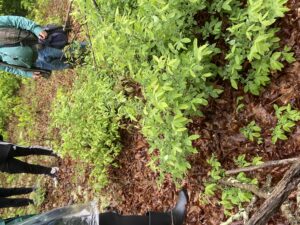
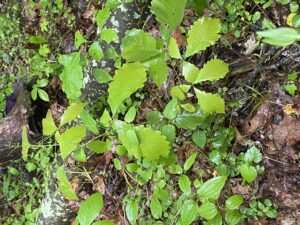
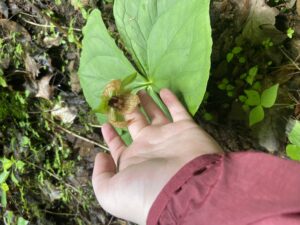
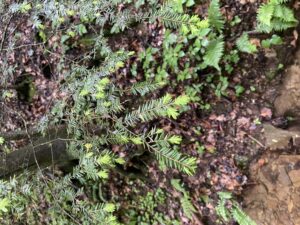
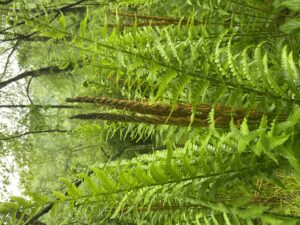
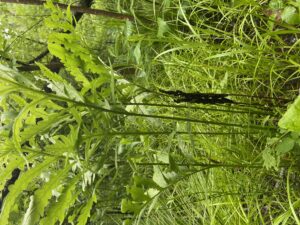
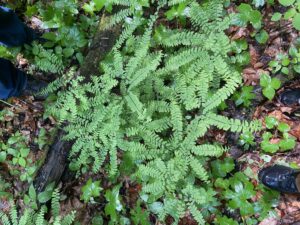
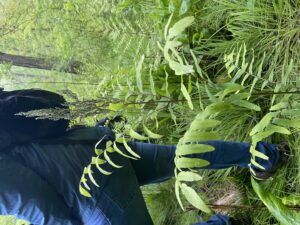
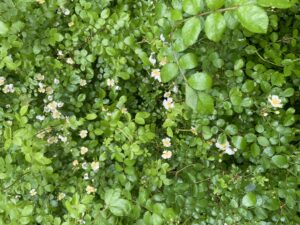
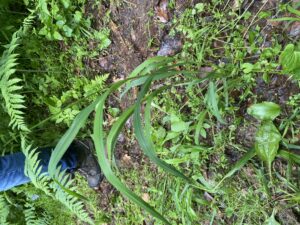
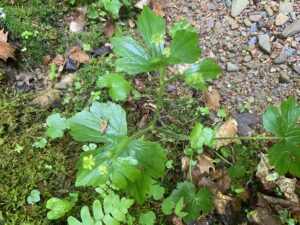
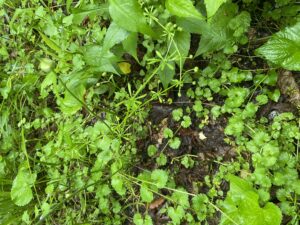
Comments
Deep Woods (Hocking Hills Adventure) — No Comments